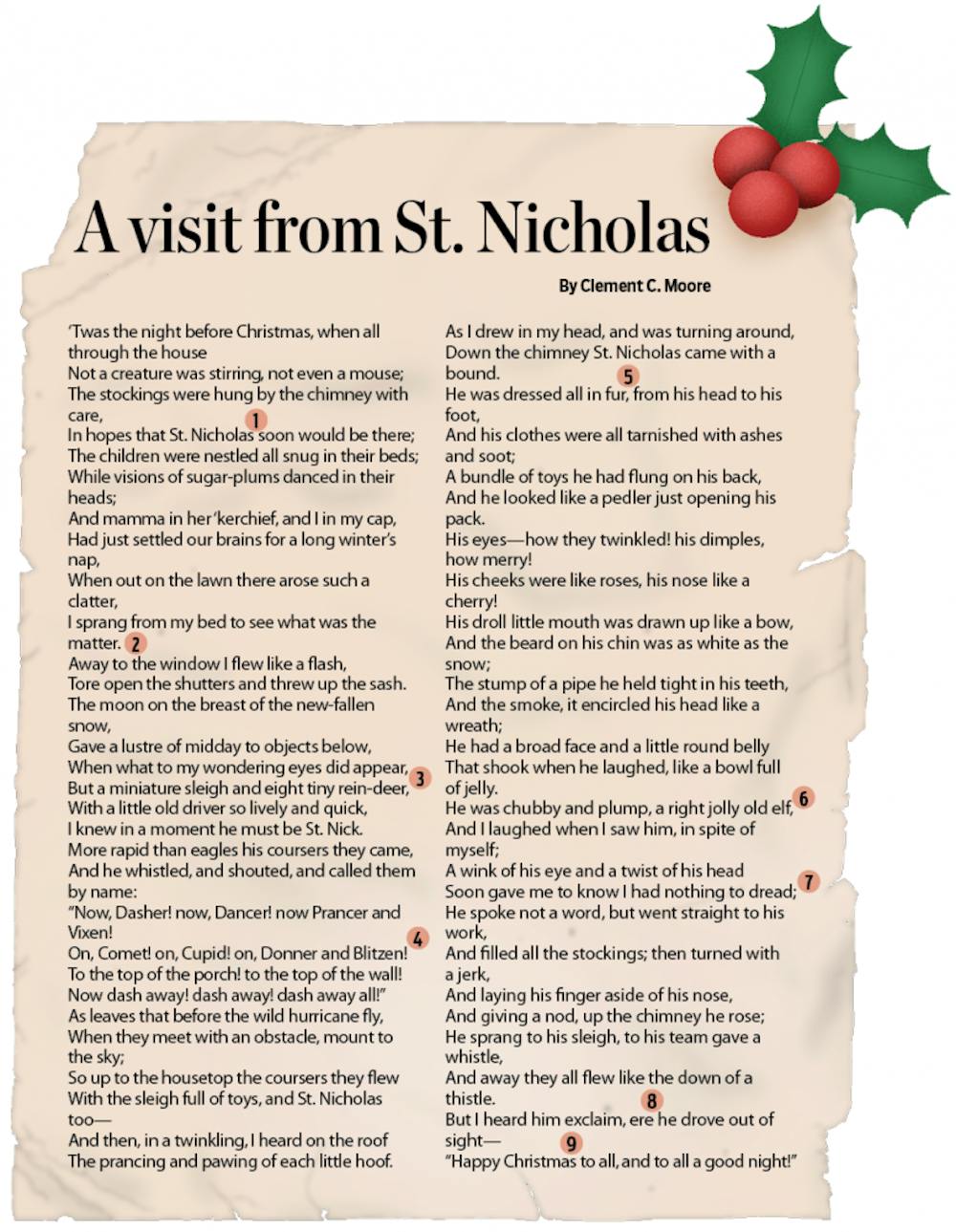We all know Santa Claus, the jolly philanthropist of the North Pole. But where did he come from? Though inspired by the real-life St. Nicholas, who lived circa 280, many credit Clement C. Moore's 1823 poem as the origin of the modern character. Below is the poem printed in its entirety, along with insight as to how it defined our modern Saint Nick.
“Twas the Night Before Christmas," or "A Visit From St. Nicholas,” by Clement C. Moore
'Twas the night before Christmas, when all through the house
Not a creature was stirring, not even a mouse;
The stockings were hung by the chimney with care,
In hopes that St. Nicholas[1] soon would be there;
The children were nestled all snug in their beds;
While visions of sugar-plums danced in their heads;
And mamma in her 'kerchief, and I in my cap,
Had just settled our brains for a long winter's nap,
When out on the lawn there arose such a clatter,
I sprang from my bed to see what was the matter[2]
Away to the window I flew like a flash,
Tore open the shutters and threw up the sash.
The moon on the breast of the new-fallen snow,
Gave a lustre of midday to objects below,
When what to my wondering eyes did appear,
But a miniature sleigh and eight tiny rein-deer[3]
With a little old driver so lively and quick,
I knew in a moment he must be St. Nick.
More rapid than eagles his coursers they came,
And he whistled, and shouted, and called them by name:
"Now, Dasher! now, Dancer! now Prancer and Vixen!
On, Comet! on, Cupid! on, Donner and Blitzen! [4]
To the top of the porch! to the top of the wall!
Now dash away! dash away! dash away all!"
As leaves that before the wild hurricane fly,
When they meet with an obstacle, mount to the sky;
So up to the housetop the coursers they flew
With the sleigh full of toys, and St. Nicholas too—
And then, in a twinkling, I heard on the roof
The prancing and pawing of each little hoof.
As I drew in my head, and was turning around,
Down the chimney St. Nicholas came with a bound.
He was dressed all in fur [5] from his head to his foot,
And his clothes were all tarnished with ashes and soot;
A bundle of toys he had flung on his back,
And he looked like a pedler just opening his pack.
His eyes—how they twinkled! his dimples, how merry!
His cheeks were like roses, his nose like a cherry!
His droll little mouth was drawn up like a bow,
And the beard on his chin was as white as the snow;
The stump of a pipe he held tight in his teeth,
And the smoke, it encircled his head like a wreath;
He had a broad face and a little round belly
That shook when he laughed, like a bowl full of jelly.
He was chubby and plump, a right jolly old elf [6]
And I laughed when I saw him, in spite of myself;
A wink of his eye and a twist of his head
Soon gave me to know I had nothing to dread [7]
He spoke not a word, but went straight to his work,
And filled all the stockings; then turned with a jerk,
And laying his finger aside of his nose,
And giving a nod, up the chimney he rose;
He sprang to his sleigh, to his team gave a whistle,
And away they all flew like the down of a thistle.
But I heard him exclaim, ere [8] he drove out of sight—
“Happy Christmas[9] to all, and to all a good night!”
1. Author Washington Irving is often credited with the birth of the modern St. Nick in 1809. Moore's version builds that into the much more recognizable character of today. Coca-Cola further developed Santa Claus in the 1920s and '30s.
2. Moore is said to have written the poem during a shopping trip for his children on a sleigh. No one knew he wrote the poem until 1844, due to his reluctance to associate with the "unscholarly" work. He ended up acknowledging it at the insistence of his children, for whom he wrote the poem.
3. Though artists had depicted St. Nick with a single reindeer before, this is the first appearance of all eight reindeer. Rudolph, the legendary ninth, came in a 1939 book by Robert L. May.
4. Moore originally named these two reindeer "Dunder" and "Blixem," Dutch for "Thunder" and "Lightning," respectively. Editor Edmund Stedman reprinted the poem in 1900 with the updated German names, which carry the same meaning.
5. Many of St. Nick's characteristics — his sooty, pipe smoking and jovial demeanor — are taken from a friendly Dutch handyman Moore knew.
6. Before the Coca-Cola advertising campaigns in the '20s and '30s, St. Nick was sometimes depicted as an elf, sometimes a human.
7. Moore shows class bias: By portraying St. Nick as a fur-wearing, pipe-smoking, soot-stained man from the chimney, he portrays the idea that St. Nick might be a lower-class thief.
8. Later versions of the poem change "ere" to "as," which changes the meaning. "Ere" indicates the exclamation was heard before he disappeared. "As" indicates it happened as St. Nick vanished.
9. The expression "Merry Christmas" arose from this line.






